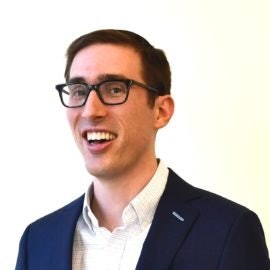 Oliver Schak, research director at TICAS and one of the report's authors
Oliver Schak, research director at TICAS and one of the report's authors
“If you compare this report to previous years, we consistently see debt is higher in Northeastern states and lower in Western states,” said Oliver Schak, research director at TICAS and one of the report’s authors. “We also continue to see debt is higher at private, nonprofit institutions and lower at public institutions.
This is the 16th annual report from TICAS on debt for bachelor’s degree graduates of public and nonprofit colleges. The report noted it did not include national figures for the share of the Class of 2020 with debt or their average debt. The U.S. Department of Education’s next set of data that will cover graduates from the Class of 2020 is not expected to be released this year.
Schak added that the report found disparities between states in not only how much average student debt graduates had but what kind of debt. For instance, out of the top ten states with the highest student debt average overall, eight of those states also ranked in the top ten among those with the highest private student loan debt average.
While the report does not take on the possible reasons for such differences, Schak highlighted the importance of investing in public institutions.
“It remains the case that typically debt loads are lower at public institutions, which tend to have much lower tuition and fees than private nonprofits,” said Schak. “But there’s been a long-term downward trend in investment in public institutions, so policy makers should really be looking to reverse that and start increasing investment at the federal and state levels.”
Dr. Liang Zhang, a professor of higher education at New York University, studies higher education economics, finance, and public policy. In response to the TICAS report, he pointed out that the numbers in the analysis are only out of those graduates who borrowed, though not all students do. He said that roughly 65% of students graduate with student loans.
“I think for-profit colleges are also something visibly missing here, and the authors do recognize this in the report,” said Zhang. “In terms of the proportion of students who borrow and in terms of the average loan amount that those students borrow, the for-profits tend to be much worse than public and private nonprofit colleges.”
For-profit institutions voluntarily give their student debt data, and the authors noted in the report that not enough information was available to analyze these colleges. Zhang said that absence is not a critique of the report yet speaks to the need to make debt data at for-profits more public.
“Also, the report focuses on college graduates, which I think is fine, but we should keep in mind that generally if someone graduated with a college degree, that makes loan repayment easier,” said Zhang. “For college dropouts, repayment is much more difficult.”
The report noted as well that students who are low-income, first-generation, and/or of color tend to take on more student debt, particularly private loans, which are riskier than federal loans. Schack stressed the importance of this point.
“Policymakers can think about ways to funnel students towards federal loans if they do need to borrow,” he said. “And one question for researchers is what the consequences of borrowing private student loans are. Why are they more common at some institutions than others—or for some students more than others?”
The report touches as well on affordability challenges specifically for undocumented students. Regarding barriers to college that underrepresented students face, Dr. Tatiana Melguizo, a professor at the University of Southern California’s Rossier School of Education, added that the pandemic has exacerbated socioeconomic and racial inequities.
“We are at a really tough time,” said Melguizo. “We saw the Biden administration couldn’t pass the free community college plan, and all this just means students will be paying emotionally and financially for the brutal impact that the pandemic has brought to their lives.”
Melguizo’s research focuses on community colleges, which often cost much less than four-year institutions and educate more students of color and low-income students. The varying economic value of a degree compared to cost raises more questions for her on college affordability in general.
“If you then think about a student going to a nonprofit private college and paying in some cases an outrageous amount of tuition and fees, these kids are on the hook for those loans that can be predatory for generations,” said Melguizo. “This will be really detrimental. If students start to see that this investment didn’t pay off, for instance, they won’t encourage their family members to get degrees.”
Looking ahead, Schak said there remains uncertainty around the pandemic’s impact for students today and those who graduated in 2020. For instance, college enrollment and persistence rates have been trending downwards in COVID-19. What that trend means could take years to be fully understood.
“If fewer people are going to college, what are the long-term consequences of that for people who are not benefitting from a college education? And in what ways does that intersect with pre-existing inequities?” said Schak. “There’s so much we just still don’t know.”
Rebecca Kelliher can be reached at [email protected].
















